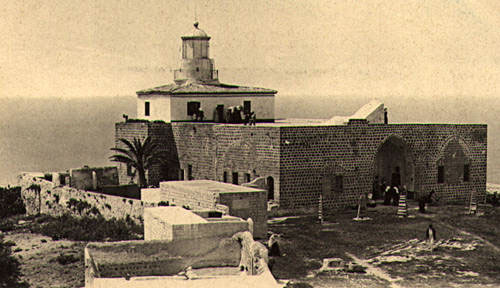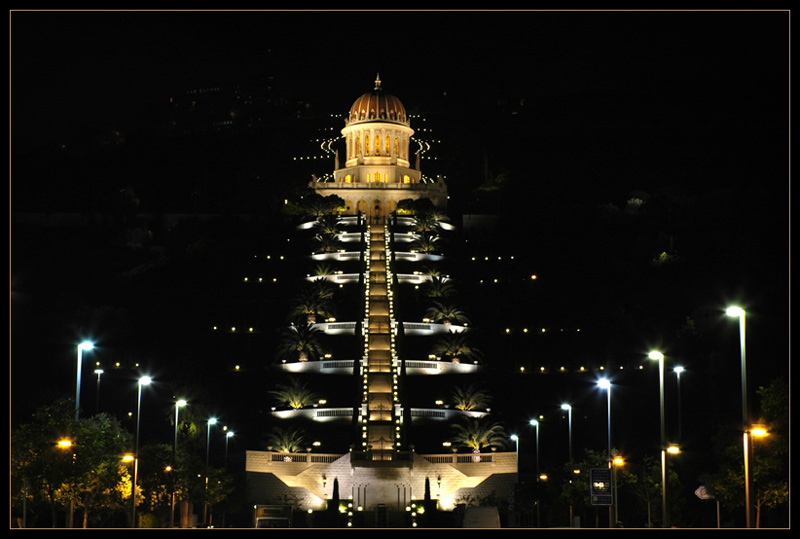

Haifa, Summer residence of `Abd-Allah Pasha with old lighthouse. Illuminated Shrine of the Bab in Haifa.
[5]
`Akka = Acre, Haifa, Bahji+ (Ottoman Palestine) (1868-1892).
`Akka = Acre

Some key books and Articles abour Acre and its History
Encyclopedia of Islam
Dumper, Michael R.T. and Bruce E. Stanley (eds.)
- Cities of the Middle East and North Africa. A historical encyclopedia. ABC-Clio: Santa Barbara, Calif., Denver, Colorado, and Oxford, England 2007. In this volume there is an entry Acre by Michael Dumper spanning pages 3-7 . It commences, "Acre Population: 46,000 (2005 estimate) Since ancient times, the gateway to Palestine has been considered the magnificent harbor at Acre.Now a small Israeli city with a mixed population of Palestinians and Jews, Acre has for more than 4,000 years served the hinterland of southern Syria with access to the long-distance trade routes of the Mediterranean. For a millennium a Canaanite city often under the direct rule of the pharaohs in Thebes, the city was ...
- Acre (Canaanite, Akko or Akka; Greek, Ace-Ptolemaïs; Latin, Saint Jean d’Acre or Acre) is an ancient port city located on the eastern Mediterranean littoral. It sits on the northern corner of the large bay of Haifa (formerly the bay of Acre) on a small peninsula that juts out into the sea where the river Belus drains the plain of Akko; eight miles to the south, at the southern tip of the bay, lies Haifa...
Expanded Bibliography+.
Further Readings
Efrat, Elisha.Urbanization in Israel. London: Croom Helm, 1984.
Lustick, Ian. Arabs in the Jewish State: Israel’s Control of a National Minority. Austin: University of Texas Press, 1980.
Makhouly,Naim, and C. N. Johns. A Guide to Acre. Jerusalem: Greek Convent Press, 1946.
Malkin, Irad,and Robert Hohlfelder, eds.Mediterranean Cities: Historical Perspectives. London: Frank Cass, 1988.
Mayer, Leo A., and J. Pinkerfield. Some Principal Muslim Religious Buildings in Israel. Jerusalem: Ministry for Religious Affairs, Government Printer, 1950.
Philip, Thomas.Acre: The Rise and Fall of a Palestinian City, 1730–1831. New York: Columbia University Press, 2001.
Rubin, Morton.The Walls of Acre: Intergroup Relations and Urban Development in Israel. New York: Holt,Rinehart and Winston, 1974.
Haifa.

Clifford E. Bosworth (d. ) ed.
- Historic Cities of the Islamic World. Leiden, Boston: Brill, 2007. This volume to some extent updates and improves EI2 articles'.
- Haifa (Hayfa) by ed. & C.E. Bosworth, pp. 149-151: "HAIFA, in Arabic script Hayfa, in Hebrew Mehoz Hefa, a port and city on the Mediterranean coast of Palestine, originally lying at the foot of Mount Carmel but now extending up it, in lat. 32º 49' N.,long. 34º 59' E. Since 1948 it has been within the State of Israel.... (2007: 149) ... The present population comprises 270,000 in the city itself, but over half-a-million in the metropolitan area, including a considerable Arab element: Muslims, including Amadiyya; Druzes; Christians, mainly Maronites; and Baha’is (Haifa being the world centre of the Baha’i faith, see above)...(2007: 151) .
- Extnded B i b l i o g r a p h y
R. Guérin, Description de la Palestine, ii, Samarie, Paris 1876, 251–9, i, Galilée, Paris 1880, 499–500; L. Oliphant, Haifa, or life in modern Palestine, London 1887; G. Le Strange, Palestine under the Moslems, London 1890, 446; E.T. Dawling, The town of Haifa, in Quarterly Survey of the Palestine Exploration Fund (1914), 184–91; H.C. Luke and E. Keith-Roach, The handbook of Palestine and Trans-Jordan2, London 1930, 71, - 132–3; J.J. Rothschild, History of Haifa and Mt. Carmel, Haifa 1934; A.-S. Marmardji, Textes géographiques arabes sur la Palestine, Paris 1951, 58; G. Kirk, The Middle East 1945 –1950, London 1954, 261–3; Walid Khalidi, The fall of Haifa, in Middle East Forum (Dec. 1959), 22–32; H. Sacher, Israel, the establishment of a state, London 1952, 241–5; M. Seikaly, Haifa. Transformation of a Palestinian Arab society 1918–1939, London 1995; M. Yazbak, Haifa in the late Ottoman period 1864 –1914. A Muslim town in transition, Leiden 1998; Kay Prag, Israel and the Palestinian territories, Blue Guides, London 2002, 286–93.
The Templar Community - Tempelgesellschaft in Ottoman Times..
Alex Carmel:
- Die Siedlungen der württembergischen Templer in Palästina 1868–1918. Ihre lokalpolitischen und internationalen Probleme. Kohlhammer, Stuttgart 1973, 19972.
- Ejal Jakob Eisler: Der Kaiser reist ins Heilige Land, Kohlhammer, Stuttgart 1999.
Paul Sauer:
- Uns rief das Heilige Land. Die Tempelgesellschaft im Wandel der Zeit. Stuttgart 1985.



